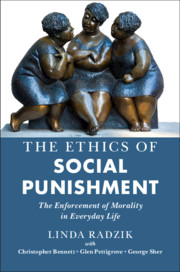Book contents
- The Ethics of Social Punishment
- The Ethics of Social Punishment
- Copyright page
- Dedication
- Contents
- Notes on Contributors
- Preface
- Part I The Descartes Lectures 2018
- Part II Commentaries
- Chapter 4 How to Do Things with Blame (and Social Punishment)
- Chapter 5 On Social Punishment
- Chapter 6 Punishment and Protest
- Part III Replies
- Bibliography
- Index
Chapter 4 - How to Do Things with Blame (and Social Punishment)
from Part II - Commentaries
Published online by Cambridge University Press: 30 October 2020
- The Ethics of Social Punishment
- The Ethics of Social Punishment
- Copyright page
- Dedication
- Contents
- Notes on Contributors
- Preface
- Part I The Descartes Lectures 2018
- Part II Commentaries
- Chapter 4 How to Do Things with Blame (and Social Punishment)
- Chapter 5 On Social Punishment
- Chapter 6 Punishment and Protest
- Part III Replies
- Bibliography
- Index
Summary
Linda Radzik claims that rebukes can and often should be seen as informal social punishments. In this chapter, Christopher Bennett disagrees. However, because he does not want the dispute to be a merely verbal one, his aim in this response is to draw out what is at issue when we disagree over whether something should be classed as punishment. Having set out the key parts of Radzik’s position and registered some concerns that he has about it, Bennett sets out a taxonomy of things that we can do with blame or social punishment, aiming to show why we might have reason to put different kinds of responses into different categories. Which of these categories we decide to call ‘punishment’ does not matter too much as long as we are clear on the underlying differences between these types of response and the different types of challenge they set us in any attempt to justify or practice them.
Keywords
- Type
- Chapter
- Information
- The Ethics of Social PunishmentThe Enforcement of Morality in Everyday Life, pp. 75 - 98Publisher: Cambridge University PressPrint publication year: 2020
- 1
- Cited by



